Biosecurity along the shrimp value chain

Biosecurity, an integral aspect of health management, is an ever-evolving practice that should form the foundation of aquaculture husbandry management (Subasinghe et al., 2023; Subasinghe & Shinn, 2023). It should be tailored to the specific conditions of each step in the culture cycle and diligently implemented daily. This article focuses on seven crucial areas: shrimp-related aspects, water management, feed utilization, system usage, biosecurity measures for personnel involved in shrimp production, the risk of infections spreading through equipment, and airborne risks. These key considerations encompass the entire process from broodstock to larval production and eventually to grow-out stages.
To underscore the importance of robust onsite biosecurity, a recent study conducted by Intriago et al. (2023) serves as a compelling example. The study shed light on the significant impact of Vibrio infections in hatcheries and nurseries. According to their findings, Vibrio species carrying VpPirAB genes were responsible for acute mortality events, with mortality rates reaching as high as 100%. These events occurred suddenly, sometimes within a mere 2-hour timeframe, primarily affecting early-stage Penaeus vannamei post-larvae.
Given the gravity of such outbreaks, this article aims to explore some of the key biosecurity considerations throughout the shrimp production chain. It will begin by addressing measures concerning broodstock, then look at biosecurity practices during the hatchery and nursery phases, and finally, encompass biosecurity protocols during the grow-out phase. Adopting stringent biosecurity measures at each stage is imperative to safeguard the health and productivity of shrimp farms and mitigate the impact of infectious pathogens like Vibrio etc.
Biosecurity considerations in broodstock and multiplication centres
Starting with the biosecurity of shrimp broodstock and breeding centres, it is important to highlight the importance of genetic selection in breeding for resistance against key pathogens. Shrimp reared in biosecure facilities demonstrating freedom of specific pathogens are Specific Pathogen Free (SPF). If these shrimp, however, are then transferred to non-secure facilities and are exposed to pathogens, then the shrimp can develop disease and there can be mortalities. Specific Pathogen Resistant (SPR) stocks are those that have been bred to be resistant to specific pathogens. This means that if the shrimp are exposed to the pathogen, they still might get infected, but they are able to limit the infection so that mortalities do not result. The third is Specific Tolerant Shrimp (SPT) – again bred to tolerate specific pathogens. If the shrimp are then exposed to a pathogen, they may or may not get infected but the level of disease or the level of mortality manifested by this population or line of shrimp is likely to be lower than you would see in normal shrimp stocks.
There are risks associated with feeding live or fresh diets to broodstock. These diets may consist of polychaetes, squid, mussels, etc. While only the mantle of squid is typically used and prepared as a frozen product, the risks of contamination with pathogens causing disease in shrimp are low. For polychaetes, typically the whole worm is used, and it is important to be aware of the potential risks of infection in non-SPF supplies from various viral and bacterial pathogens and from the microsporidian Ecytonucleospora [Enterocytozoon] hepatopenaei (EHP). There are companies that supply live SPF polychaetes and others that supply frozen polychaetes. The lower performance of broodstock consuming a frozen product in terms of the number of spawnings per female, fecundity, egg hatch rate, and the percentage surviving to the zoea stage, that is commonly reported is an important consideration for producers deciding to use live polychaetes. Where SPF polychaetes are not available or not an option, then there is a need to lower the biosecurity risks associated with the vertical transmission of diseases agents, by reducing or eliminating the polychaetes component of broodstock diets.
In a field trial, looking at the performance associated with different formulations of maturation diet, a 100% fresh food diet was tested alongside a diet of 40% semi-moist pellet and 60% fresh food including polychaetes, against a diet of 60% semi-moist pellet diet and 40% fresh food but no polychaetes (Hoa, 2010). The trial found that the diet in which 60% fresh food was replaced with a semi-moist feed statistically (p<0.05) outperformed the other dietary treatments in the number of spawns per female, in egg hatching rates, and percentage reaching zoea. Fecundity was also higher but was not statistically significant. The tested semi-moist feed was consequentially commercialized in 2010 as BREED-S.
In broodstock management, certain practices such as eyestalk ablation in shrimp production can affect the infection chances and the robustness of adult shrimp and their ability to cope with disease challenges. A study by Zacarias et al. (2021) looked at the effect of eyestalk ablation on the robustness of their offspring. Two disease challenge trials, one for Acute Hepatopancreatic Necrosis Disease (AHPND) and one for whitespot virus, challenged shrimp from either ablated or non-ablated mothers. In both trials, the offspring from non-ablated females had greater rates of survival, significantly so when challenged with an isolate of Vibrio parahaemolyticus causing AHPND.
Looking at the water supplied to broodstock centres and to hatcheries, it is important to ensure this is sterilized, is biosecure, and this can be achieved using ozone and UV. Air that is drawn in is exposed to an electric current which separates the oxygen atoms which then reassemble as O3 or ozone which is then mixed with the incoming water supply. Ozone acts by oxidizing cellular membranes destroying pathogens. The ozone treated water then passes through a UV system which destroys any residual ozone and any toxic hypobromous acid and bromamines that are produced – the UV light inducing photochemical reactions that can break down or alter the chemical structure of these compounds. The added value of ozone is that dissolved waste material can partially be oxidized by ozone with toxic nitrogen compounds being oxidized to NO3. A protein skimmer can be used to remove protein compounds and other organic compounds from the water.
An alternative approach is to use electrolysed seawater where hypochlorite is produced by electrolysis. This can be used to treat large volumes of both incoming and wastewater. The system needs to be used in conjunction with charcoal filters to remove any residual chlorine. For some major pathogens like EHP, much work is still needed to define the minimum doses required to ensure their effective sterilization. Another approach to ensure the biosecurity of the water that is used is to employ ultrafiltration. Systems are now available that can retain particles as small as 0.03 microns – so effectively filtering out bacteria and EHP spores.
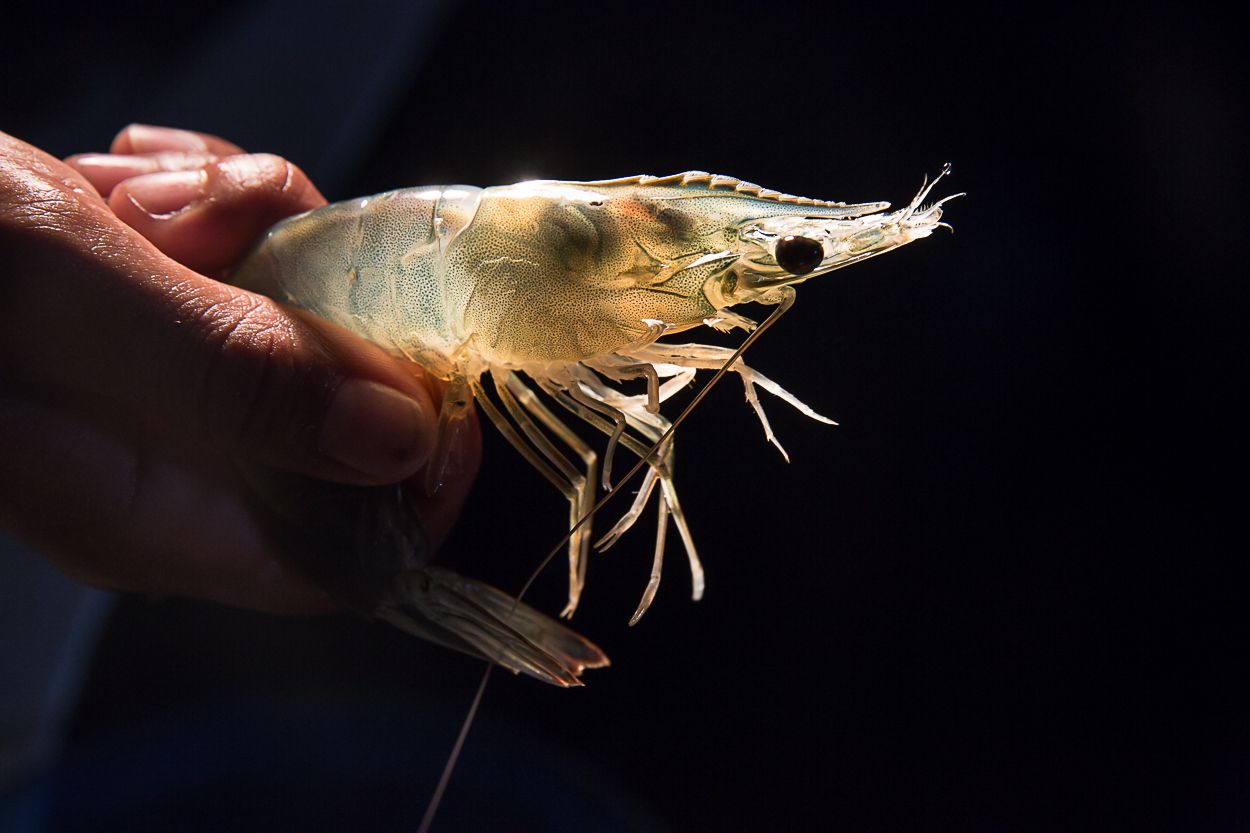
Bacteria may enter the culture system through airborne routes, including the air supply bubbled through the water, aerosols from neighbouring tanks, or from air currents in the facility. To prevent this, it is essential to fit air filters to the intake of air blowers. These filters can be made of fine mesh nylon (e.g., plankton net) or paper/cellulose-based filters like those used in car air filtration. By stacking them in series, large volumes of air can be efficiently filtered down to 10 microns, ensuring the culture system remains protected from potential bacterial contamination.
For facilities requiring higher levels of biosecurity, air filters are crucial for reducing the spread of airborne pathogens. They can help prevent the transmission of infectious diseases by capturing and removing droplet nuclei, aerosols, and airborne particles that may contain harmful microorganisms. High-efficiency particulate air (HEPA) filters on air intake / outlet systems and fitted to air conditioning units are among the most efficient filters and can remove up to 99.97% of particles as small as 0.3 microns and can be employed where strict air quality standards are necessary.
Biosecurity considerations in the hatchery and nursery phases of production
The design of production sites should be carefully planned to minimize the risk of cross-contamination between different sections, enable efficient management and treatment of water flow, and facilitate the effective isolation and disinfection of each production unit on a routine basis. To ensure robust farm biosecurity, procedures must be established for obtaining clean sources of pathogen-free shrimp seed and feed. This involves implementing standard operating procedures (SOPs) for receiving new stock into the facility, ideally with a secure quarantine area. Moreover, protocols should be established for regular cleaning and disinfection, and these measures should be clearly communicated, regularly reviewed, and updated when necessary.
It is essential to identify control points and implement procedures that aim to prevent, reduce, or eliminate potential health threats. The scope of biosecurity practices should encompass various aspects, including the source and quality of shrimp at each stage of production, stocking densities, feed and feeding regimens, water system preparation, disinfection, and overall management. Regular health surveillance is crucial to monitor the well-being of hatchery and farm stock, as well as to maintain the site’s sanitary status. In addition, emergency plans should be developed, and pre-prepared action plans should be in place ahead of any potential disease outbreak. By adopting these comprehensive biosecurity measures, shrimp farms can enhance their overall farm practices and reduce the risk of disease spread and other health-related issues.

Taking a deeper look at some of the biosecurity strategies employed in the hatchery, a key consideration is the microbial management of the culture environment. On-site practices need to drive the management of the system so that a balance between r versus K strategists is achieved. R strategists are species living in unstable and unpredictable environments and can undergo rapid reproduction to stabilize themselves; they can be dangerous opportunistic pathogens. K strategists by comparison are species living in stable environments – they typically have low or slower growth and are generally harmless. Achieving a balance between these two determines the risk for bacterial interference although it should be stressed that this can be unpredictable.
Even with disinfection measures in place and probiotics being applied, there are still risks of disease – and in the hatchery these can be Vibrio species responsible for luminescent vibriosis, zoea-2 syndrome, bolitas and AHPND, etc., so having the correct system design and biosecurity practices in operation are crucial. Microbial (pathogen) control within the culture environment can be effectively managed using combinations of disinfectants such as Sanocare PUR and water conditioning agents such as Sanolife MIC.
Biosecurity is not only about reducing the risks of pathogen entry or about killing bacteria but critically it is about creating a stable microbiome ecosystem that reduces the probability of pathogen populations developing. If you achieve a total kill of bacteria, then you create an open environment for other pathogens entering the system. Here we can consider two hypotheses. The first and “best strategy” would be to avoid the introduction of any bacteria via live food (e.g., rotifers, Artemia, Moina, polychaetes, etc), using an effective disinfection protocol to kill any bacteria. Sterile cultures can be obtained and reduce the risk of bacteria being introduced to almost zero. A subsequent inoculation with probiotics to create a stable microbiome could complete the strategy but is not a must if the introduction of undesirable species of bacteria can be guaranteed.
The second hypothesis / strategy is that the microbial management of algae and PL tanks is the preferred way forward because of the impossibility of having cultures of algae and or PL in the field that are free from living organisms other than the algal species or PL that are required (i.e., axenic cultures). In relation to this matter, crucial aspects in these environments must include water management, air quality control, and microbial management.
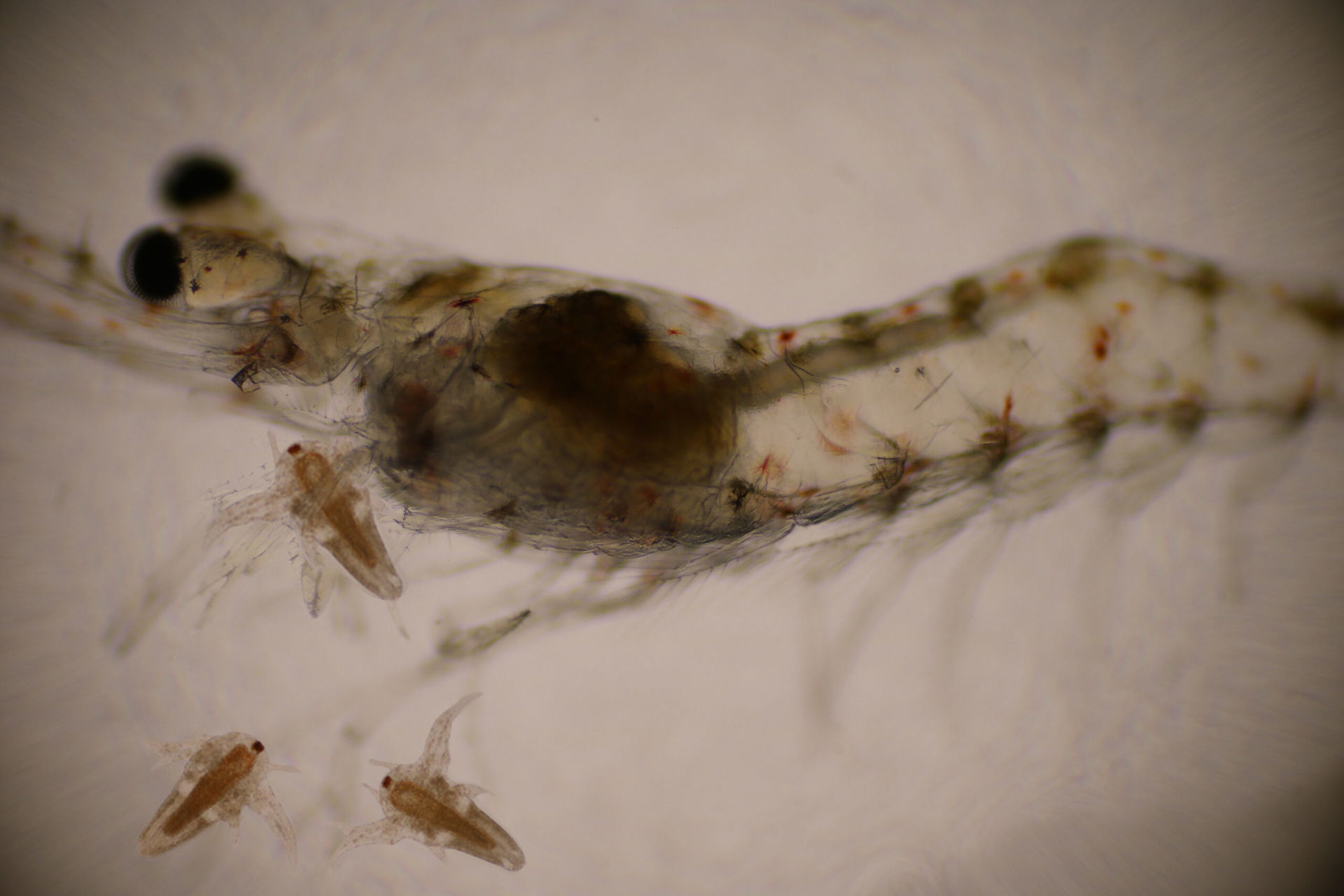
A recent study undertaken by Heyse et al. (2021) found that the phytoplankton community is an important driver of the rearing water microbiome. From their study, source tracking analysis revealed that each of the investigated sources (i.e., algae, Artemia, water and feed) was responsible for the presence of specific taxa in the microbiome of the larval shrimp rearing water. Based on their analysis, it was demonstrated that the largest proportion of introductions of new bacterial species could be attributed to the microbiome of the algae, followed at a later stage by that of the Artemia, the exchanged water and – to a low extent – the dry feeds. This demonstrates the crucial role those peripheral microbiomes play in challenging or maintaining a health-promoting microbial balance.
This study also provides key knowledge for us to use in working towards systems with better microbial management and biosecure practices, including protocols on how bacteria can be reduced, controlled, and managed with probiotics, water exchanges, biofilters (RAS (recirculating aquaculture system), water management (biofloc), and solutions increasing the quality and biosecurity of feeds and practices.
Algae can, therefore, have a major impact on the microbiome, and this needs to be addressed. The way that algae is being produced, notably in Asia, is typically in open cultivation systems which means that they are at high risk of contamination, unpredictable and variable. By moving the culture of algae into photobioreactors or closed reactors, where culture conditions are carefully controlled, means that algae can be produced in a more stable microbial environment, allowing them to be fed in a more biosecure way, limiting and controlling much better the introduction of new microbial species into the system.
Further, the presence of Vibrio-free cultures of Chaetoceros calcitrans and Tetraselmis suecica microalgae, were found to significantly inhibit (p<0.05) the growth of V. parahaemolyticus during co-cultivation (Soto-Rodriguez et al., 2022). Live food plays a significant role in the dietary needs of cultivated species, owing to its exceptional nutritional value and diverse biochemical composition. Its mobility, size, and different developmental stages make it an ideal food source for hatcheries to allow them to produce overall high quality and robust post larvae (PL). In addition, crucial factors for ensuring safe production include ease of production, availability, rapid development, and the presence of new technologies targeting a more efficient and more predictable production of high-quality (nutritional and microbial) live food. The quality of the Artemia nauplii and biomass can be affected by the presence of empty shells, hatching membranes and unhatched cysts as they form a perfect substrate for the development of unwanted microbial species such as Vibrio.
To improve the live food quality and to facilitate the removal of the unwanted substrate, Artemia cysts coated with specific iron particles (SEP-Art technology) are used in conjunction with static or dynamic, self-cleaning tools, such as the SEP-Art HandyMag, SEP-Art CysTM and SEP-Art AutoMag. The specially coated shells are attracted by the magnets keeping the animals alive and undamaged in the suspension. The removal of the shells results in a cleaner source of nutritionally superior Artemia nauplii for use in hatcheries.
 | |
 | 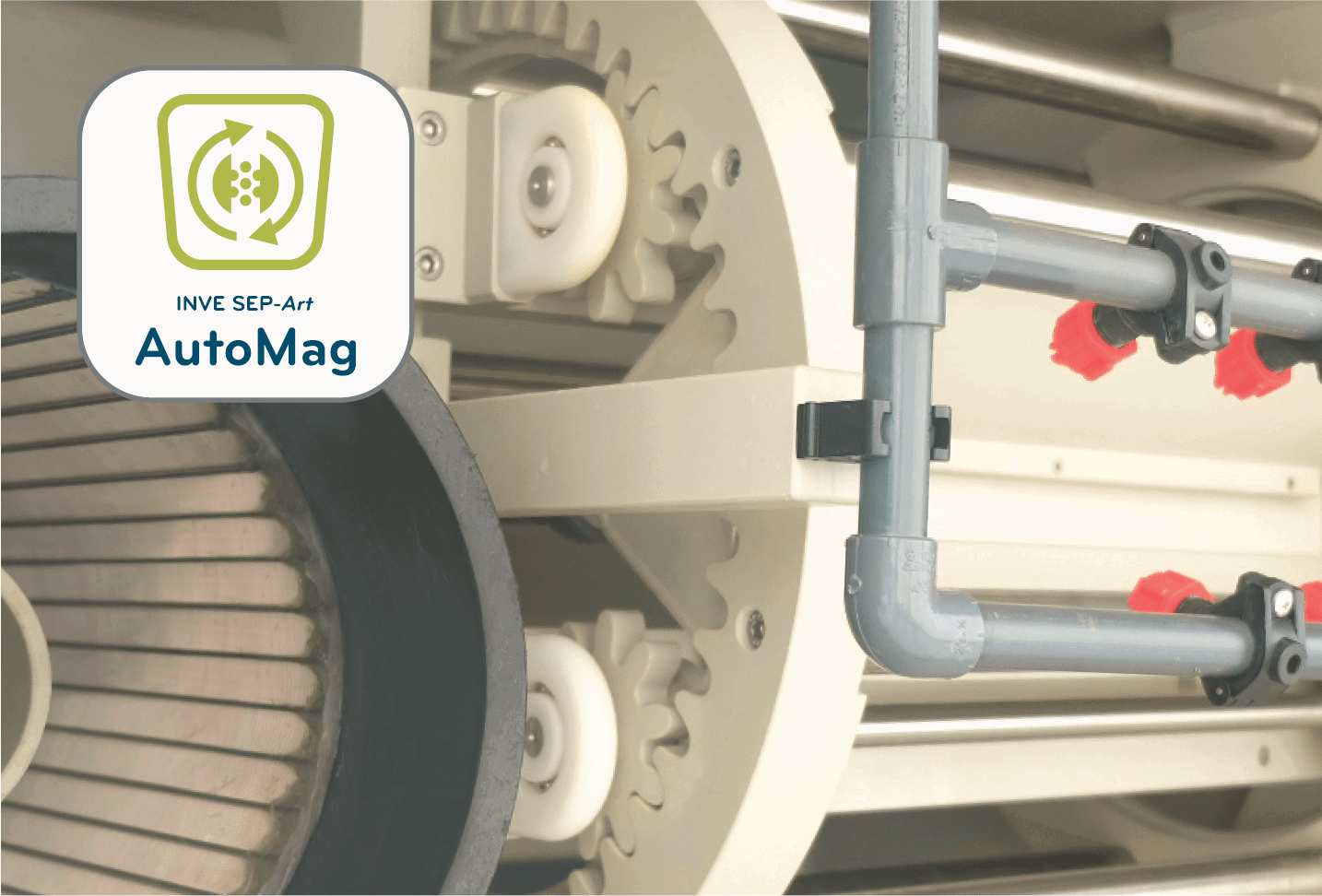 |
During the hatching and culture of Artemia, there are also specific products that can be used to lower the number of Vibrio and ensure good water quality (e.g., by using SEP-Art D-FENSE type of cysts, or by using Sanocare ACE PRO). The use of these products reduces and controls bacterial development during the production of the important live food without effecting the hatching and viability of the Artemia, generating a live food of a high microbial quality (absence of Vibrio) and limiting the transfer of opportunistic species into the PL production environment, keeping Vibrio at very low levels.
Biosecurity considerations in grow-out
From disease challenge trials, understanding the tolerance of different sized post larvae to key pathogens like Vibrio parahaemolyticus causing AHPND can provide key insight into farming practices that can reduce the impacts from disease. In one in-house trial, a single population of shrimp was followed through their development with sub-samples challenged with different doses of bacteria to define LC50 doses needed to kill different stages of PL. From the 600+ tests that were conducted, it was found that almost 80 to 100 times more bacteria were needed to kill 50% of a population of PL33 than that needed to kill 50% of a population of either PL16 or PL24. While there is no surprise that larger sized shrimp need larger doses of bacteria to kill them, the large jump in the doses required between PL24 and PL33 is interesting and can be used in decisions regarding the best time to transfer PL to ponds.
In good biosecurity and health care management, the importance of regular health screening of stocks and being able to recognize the early signs of disease cannot be stressed enough. Biofouling, the presence of bolitas, condition of the hepatopancreas, shell necrosis, gut chromatophores, gut content and faecal condition, etc., can provide insight into the health of the stock in culture systems and ongoing husbandry practices. If deviations to the normal, expected condition are seen then it is important that the relevant health or investigative tests are conducted. If these are overlooked, ignored, dismissed or there is procrastination in decision making then not only can it result in impacts to the health and survival of stocks but may result in irrevocable situations regardless of the subsequent intervention. It is also critical that health assessments on stocks are made before they are transferred into ponds.
In recent years, disease problems caused by Vibrio spp. and viruses have emerged as major constraints in aquaculture production. The application of antibiotics to culture ponds is not only expensive but also detrimental, in that it can result in the selection of bacteria that are drug-resistant or more virulent, and it can result in drug residues in reared animals ready for consumption.
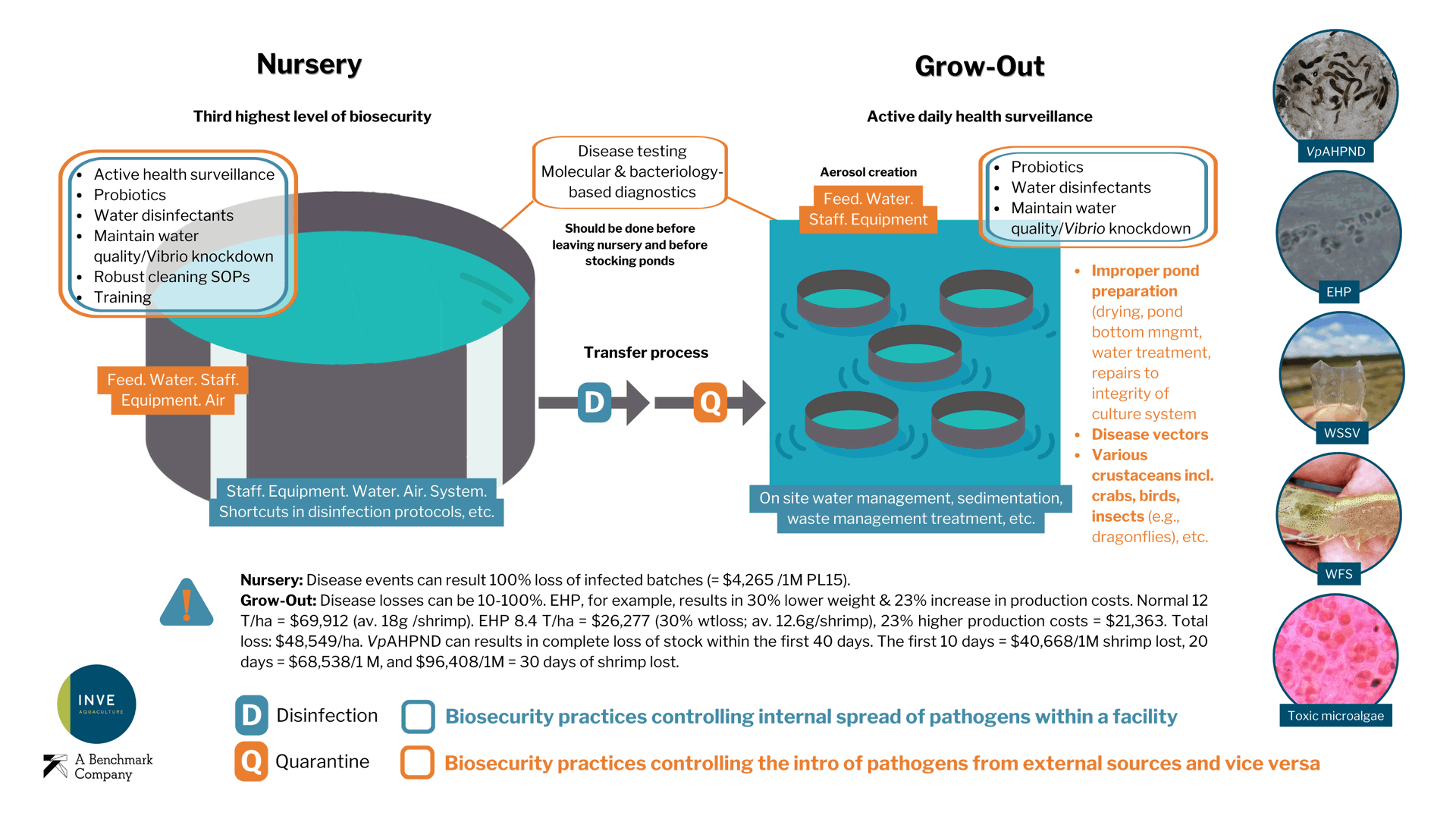
Probiotics are a valid alternative to the prophylactic application of chemicals, notably antibiotics and biocides. Beneficial bacteria, which compete with bacterial pathogens for nutrients, space and/or inhibit the growth of pathogens, can be applied to the water or to the feed. These probiotic strains are not therapeutic agents but will alter directly or indirectly the composition of the microbial community in the rearing environment and the shrimp intestinal tract. One key message is the importance of creating stable microbiomes which helps in biosecurity.
The utilization of probiotics as a microbial approach for environmental management and disease prevention in aquaculture has gained significant attention. However, a major hurdle confronting probiotics in this field is the proliferation of numerous unregulated, ill-defined, and unsuitable products available on the market, lacking scientific substantiation for their claims. The primary causes for diminished efficacy include inadequate quality control during product manufacturing and inappropriate delivery methods, resulting in contamination and/or excessive treatment expenses that are not properly controlled. The development of suitable probiotics is not a simple task and requires empirical and fundamental research, full-scale trials, as well as the development of appropriate monitoring tools and controlled production.
The effectiveness of probiotic applications in rearing media or feed relies on careful selection and deposition of strains, achieving high concentrations in water or the gut of shrimp, maintaining controlled production conditions, and integrating them wisely into standard operating procedures (SOPs) to optimize cost-efficiency. The key message is that well selected probiotics can assist the stability and the enhancement of the gut microflora and the environment in competing against hazardous species.
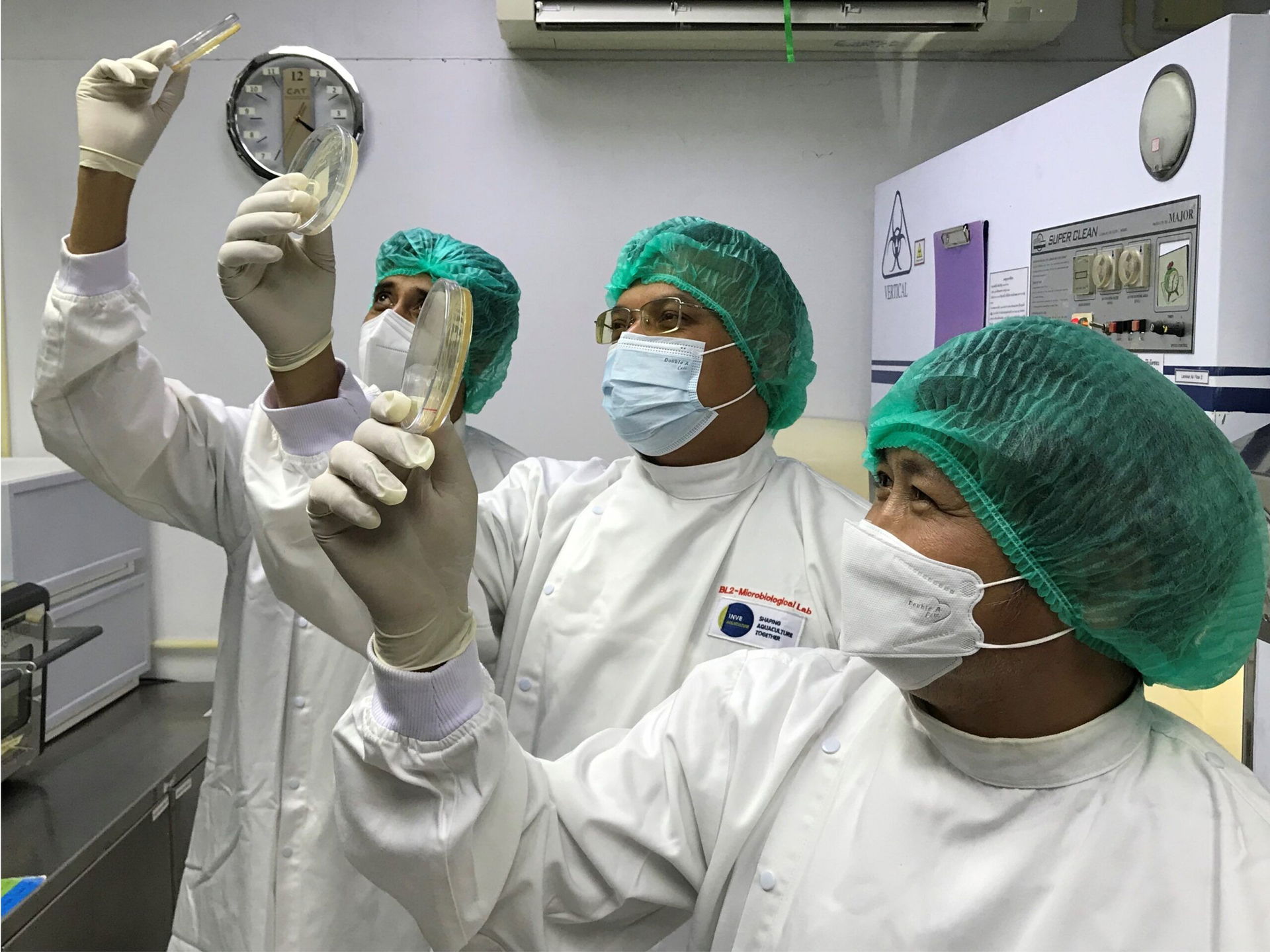
Within the context of biosecurity, Recirculating Aquaculture Systems (RAS), as managed systems, can assist in creating more stable microbiomes (water quality and microbiota). Pilot trials have demonstrated that RAS can result in significantly higher biomasses of shrimp being harvested but with 30% lower running costs than traditional systems. The RAS system resulted in better water quality and removal of solids. The systems had higher bacteria loads from the start with a more stable microbial community throughout the culture period. More work with RAS systems is needed to fine tune them for use on a commercial scale.
It is also important to consider that the transfer of PL might impose the risk of transferring biosecurity risk from the hatchery/nursery to the grow-out ponds. Minimizing the risk is key to improving the performance of the site. The risk of vibriosis can be minimized by addressing stress and by increasing robustness using specific products such as Sanocare FIT. This avoids mortalities during transportation, acclimation, and stocking to ensure PL performance into grow-out ponds is optimized.
At the production level, microbial management can be facilitated using protein skimmers to remove dissolved organics and, using biofilters in recirculation systems. In integrated farming, there is a move to reduce the number of production ponds and to increase the area dedicated for on-site water management / purification. In general terms, the lower substrate to bacteria ratio leads to greater microbial stability. To ensure on-site biosecurity measures and surveillance, it is advisable to assess the bacterial load in the culture water as well as at predetermined monitoring points within the system (such as water and air pipes) using selective media plating. In the event of a disease outbreak, it is crucial to identify the causative agent(s) through appropriate identification methods.
The importance of good system health in biosecurity should also be emphasized. On almost all production sites, the focus of biosecurity effort tends to be on ensuring the health and security of the ponds or the tanks – essentially the heart of the system. However, it is also important to consider all the supply networks feeding into and out of these systems – the pipework, aerators, airlines etc. If these are not maintained and cleaned between each production cycle, then these can also result in health problems – they can have mussel build-up in poorly filtered systems, formation of biofilms, bryozoans, etc., and we do have products within the industry to address these to make sure that systems are regularly disinfected.
Air quality also needs to be considered in our biosecurity assessment. The spread of pathogens by air by aerosols is also frequently neglected and yet the spread of pathogens by air is no big surprise especially in these COVID-19 challenged times and yet there is a real lack of data demonstrating this as an infection. Using Vibrio parahaemolyticus causing AHPND a model, a series of trials were conducted within a carefully controlled, licenced site, were able to demonstrate that bacteria can be cast great distances and that infections from infected ponds or wastewater reservoirs, if not appropriately treated, can serve as infection points potentially seeding new infections in neighbouring ponds. Similarly, the use of air pumps in broodstock centres, hatcheries and nurseries should also be fitted with air filters on their intake pipes to reduce the introduction of air borne pathogens into culture systems.

Conclusion
Adopting a holistic approach is a crucial strategy for disease prevention and environmental management, as prioritizing prevention is more cost-effective than reactive emergency treatments or uninformed mitigation efforts. A comprehensive biosecurity program should encompass preventive measures, including the use of water conditioners, microbial treatments, solutions for water and soil bioremediation, immunostimulants, and robustness enhancers supported by robust SOPs, monitoring of pathogens, staff training, regular biosecurity audits, and the implementation of good sanitary practices.
Additionally, the judicious selection of approved disinfectants, biocides, and chemotherapy agents should be implemented to maintain animal health and create an optimal rearing environment. By incorporating these strategies throughout the entire culture life-cycle, the added value they provide contributes to the sustainability and promises a promising future for aquaculture production.
Authors: Andy Shinn, Ratchakorn Wongwaradechkul, Geert Rombaut, Frederic Jozwiak, Emmy Léger, Roeland Wouters, Mayleen Chang Vasquez & Erik Van Ballaer
How can we help you to get the best results today?
Send us a request and share your concerns here or email us at customer.support@inveaquaculture.com
This article is featured on the following websites: